Are you curious to know who the top predators are in the kangaroo kingdom? Well, look no further because we’ve got the scoop for you! In this wild and captivating blog post, we’ll uncover the truth about what eats kangaroos. From the daring dingoes to the extinct Tasmanian tigers, these predators will leave you in awe of their hunting skills. But hold on tight, because even humans make it onto this fearsome list. Yes, you read that right! So, grab a seat and get ready to dive into the fascinating world of kangaroo predators. It’s going to be a wild ride!
Dingoes – The Wild Canine Predators
Deep in the heart of Australia, a fierce predator lurks, known for its strategic hunting prowess – the Dingo. This wild canine has earned a reputation as one of the primary predators of kangaroos, exhibiting a fascinating pack behavior that makes them formidable hunters.
Imagine a pack of dingoes, their lean bodies and piercing eyes, relentlessly pursuing a kangaroo across the arid landscape. They work together, coordinating their movements and taking turns chasing their prey. This relentless pursuit exhausts the kangaroo, making it vulnerable and easier to pounce upon.
These wild canines are not selective in their hunt. They target both the young joeys and the robust adult kangaroos. Yet, there is always a chance for survival for the roos. An adult kangaroo, alert and swift, can sometimes escape if they sense the danger early enough. Unfortunately, when cornered, the outcome for the kangaroo is often tragic.
| Dingo’s Predation Characteristics | Details |
|---|---|
| Hunting Method | Pack Hunting – strategic and coordinated |
| Prey | Both juvenile and adult kangaroos |
| Escape Possibility for Prey | Possible if the danger is sensed early |
| Outcome of Full-blown Confrontation | Often fatal for the kangaroo |
In the vast wilderness of Australia, the dingo’s predatory behavior plays a significant role in the natural order. Their relentless pursuit and remarkable hunting techniques make them a crucial part of the food chain, contributing to the balance of the ecosystem.
“The dingo is a wild animal, a hunter – a survivor. Its relationship with the kangaroo is a dance of life and death, a testament to the unforgiving law of survival in the wild.”
By understanding the intricate relationship between these two species, we can gain a deeper appreciation for the complexity of nature and the role each species plays in maintaining the delicate balance of life.
Tasmanian Tigers – The Extinct Predators
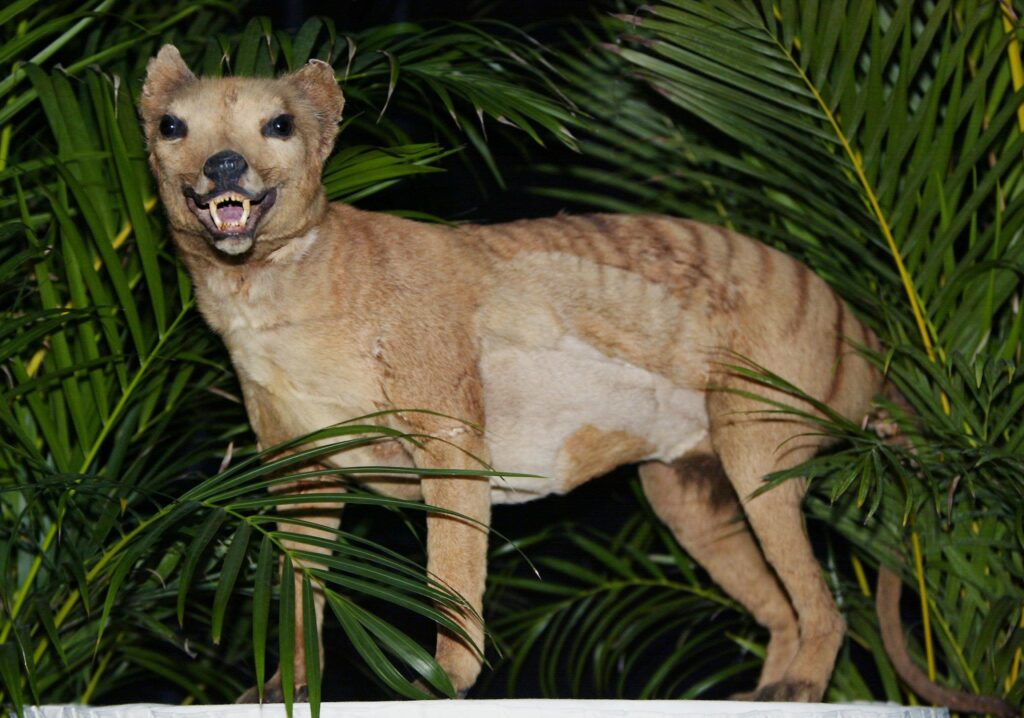
tasmanian tiger
In the annals of Australia’s wildlife history, there is a creature that left an indelible mark as a formidable predator of kangaroos – the Tasmanian tiger. This predator, now extinct, was once a force to be reckoned with, instilling fear in the hearts of kangaroos across the continent.
The Tasmanian tiger, despite its name, was not a tiger at all. Its moniker was inspired by the distinctive tiger-like stripes that adorned its lower back and tail. A native of the isolated island of Tasmania, this creature was a marsupial, a member of the same family as kangaroos and koalas.
“Tasmanian tigers were major predators of kangaroos. They could chase and kill both joeys and adult kangaroos. However, these animals were declared extinct in 1936. They were named the Tasmanian tigers because of the tiger-like stripes on their lower back and their Tasmanian island native origin. Tasmanian tigers are icons in Australia.”
The Tasmanian tiger was a predator par excellence. It hunted with a stealth and tenacity that made it a formidable adversary for kangaroos. It would relentlessly pursue its prey, often targeting both joeys and adult kangaroos, until it had worn them down and could move in for the kill.
Read more: How Fast Can Lions Run? Unveiling the Secrets Behind the Lightning Speed of These Majestic Beasts
However, their reign as top predator came to an abrupt end. In 1936, the Tasmanian tiger was officially declared extinct. The reasons behind their extinction are complex, involving a mix of hunting by humans, habitat destruction, and the introduction of dogs.
Despite their extinction, Tasmanian tigers continue to hold a revered place in Australian folklore. They are seen as iconic figures that symbolize the rich diversity of Australia’s wildlife. Their memory remains alive, not only in history books but also in the hearts of those who appreciate the intricate balance of nature.
As we move on to other predators of kangaroos, let’s not forget the Tasmanian tiger, a testament to the fleeting nature of existence and the profound impact of human activity on biodiversity.
Foxes and Wild Dogs – The Cunning Opportunists of the Outback
In the vast, untamed landscapes of Australia, even the smallest of creatures are forced to adapt, to find their niche in the delicate balance of life. Among such survivors are the foxes and wild dogs, who, despite not being the most frequent predators of kangaroos, have carved their own roles in the harsh Australian outback.
With their fiery coats and glinting eyes, foxes are creatures of cunning and agility. They are opportunistic hunters, typically focusing their efforts on the young, the vulnerable— the joeys. Imagine a fox, lithe and silent, stalking its unsuspecting target. It gives chase, relentless in its pursuit, driving the joey to exhaustion. And then, when the joey’s strength wanes, the fox strikes, delivering a fatal bite. The risk of tangling with a full-grown kangaroo, an adversary that could potentially inflict serious injuries, is often a deterrent for these solitary hunters. But for a joey, it’s a fox’s game.
Wild dogs, on the other hand, bring a different strategy to the hunting ground. They are pack animals, much like their dingo brethren, targeting both young and adult kangaroos. Their power lies in their unity, their numbers; a pack of wild dogs can indeed be a daunting sight for any kangaroo. With coordinated attacks and relentless pursuit, they embody the raw, unforgiving nature of the wild. To a kangaroo, a pack of wild dogs is nothing short of a formidable threat.
Check out: Unveiling the Enigma: What Makes the Jaglion the Rare and Mystical Hybrid of a Lion and a Jaguar?
Thus, in the grand theatre of the Australian wilderness, foxes and wild dogs play their parts— opportunistic predators, often underestimated, yet always ready to seize an opportunity when it presents itself.
Wedge-Tailed Eagles – The Aerial Predators
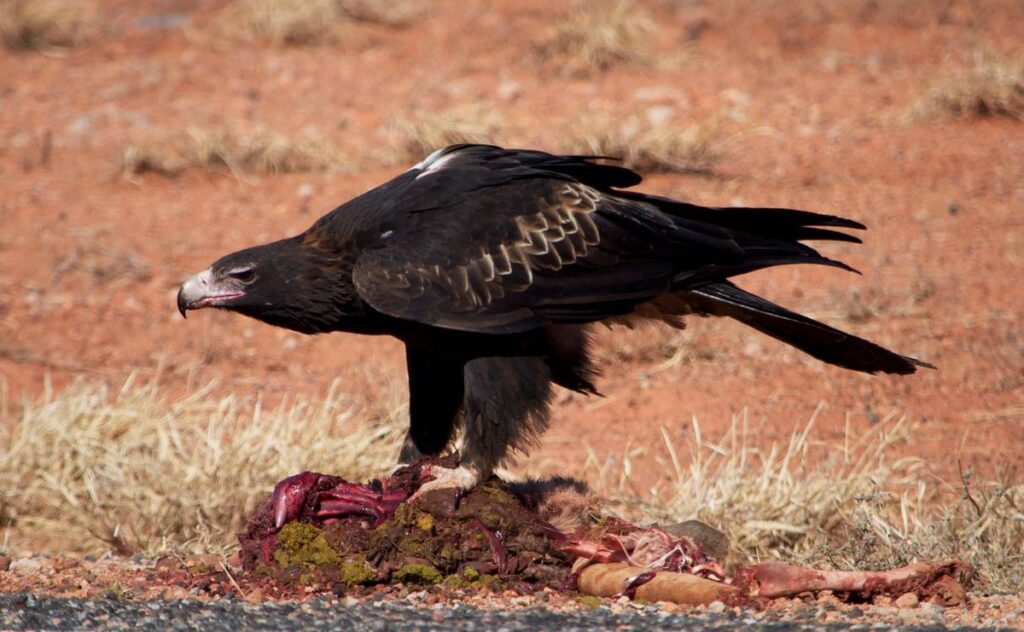
wedge-tailed eagles
Let’s shift our gaze from terrestrial predators and ascend to the expansive Australian skies, the realm of one of the kangaroo’s most fearsome adversaries – the wedge-tailed eagle. These formidable birds of prey, with their imposing wingspans and razor-sharp talons, present a significant threat to the unsuspecting young kangaroos or joeys.
Imagine this: A young joey, barely a few months old, is hopping around, exploring its surroundings under the warm Australian sun. Suddenly, a dark shadow swoops down from the azure sky, swift and silent. Before the joey or its mother could react, the predator has already taken hold. This is the terrifying reality for many young kangaroos, a testament to the lethal proficiency of the wedge-tailed eagle.
“With their swift aerial attacks, wedge-tailed eagles can easily snatch unsuspecting joeys, highlighting the dangers that kangaroos face from the sky.”
These eagles, named for the unique shape of their tails, are the largest birds of prey in Australia. They possess an uncanny hunting prowess, effortlessly soaring on thermal currents in search of their next meal. When they spot potential prey, they plunge from the sky at breathtaking speed. Their targets, often caught off guard, stand little chance against such a sudden and ferocious attack.
Young kangaroos are particularly vulnerable. Unlike their adult counterparts, who can put up a fight with their powerful hind legs, these joeys are easy prey for the fast and agile eagles. This stark reality underscores the many dangers that kangaroos face, even from the seemingly safe expanse of the open sky.
The wedge-tailed eagle’s role as an aerial predator of kangaroos showcases the intricate and often brutal interplay of predator-prey dynamics that shape Australia’s outback. As we continue our exploration into kangaroo predators, we recognize the complex challenges these marsupials face in their struggle for survival.
Humans – The Unanticipated, Yet Most Dangerous Predators
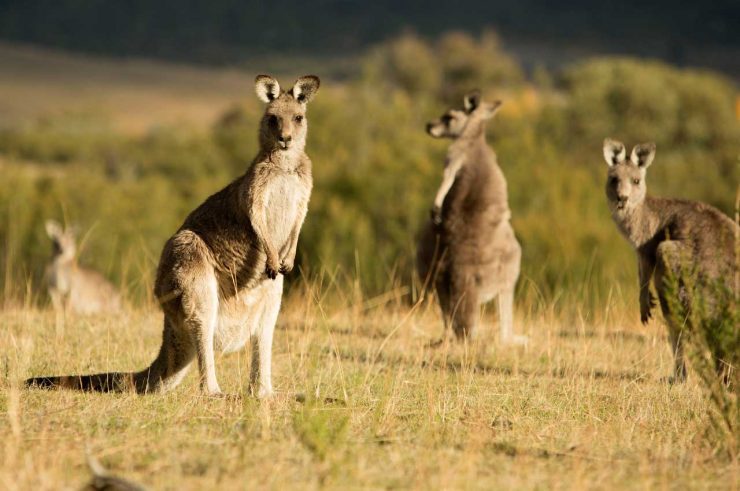
kangaroo
Strangely enough, the most formidable threats kangaroos face aren’t always those with fur, feathers, or fearsome jaws – it’s us, humans. Our species, with our developed intellect, tools, and complex systems, have emerged as the most significant and lethal hunters of these agile marsupials.
In the sun-scorched plains of Australia, kangaroos have long been a part of the local diet. Their lean, high-protein meat, once a survival necessity for indigenous populations, has evolved into a culinary delicacy over time. Not only do Australians savour kangaroo meat, but its demand has also crossed domestic boundaries, reaching the plates of gourmets in neighbouring countries.
“The legalization of kangaroo meat in 1980 transformed humans from mere spectators of the outback’s predator-prey dynamics to active participants. This shift has had profound implications for kangaroo populations.”
Following the legalization in 1980, four species of kangaroos have been approved for trade, creating a thriving and lucrative industry. This legal sanction, coupled with the growing demand for kangaroo meat, has resulted in humans becoming a significant factor in the kangaroo’s fight for survival. It’s a complex interplay of ecology, economics, and ethics that continues to shape the fate of these iconic Australian animals.
But hunting kangaroos isn’t as simple as it seems. It is governed by laws and requires a hunting license, ensuring some level of regulation and control. Despite these measures, the human appetite for kangaroo meat poses an undeniable threat to their populations.
As we delve deeper into understanding the kangaroo’s predators, we must confront our own roles in their struggle for survival. The outback’s harsh realities are a stark reminder of the intricate balance within nature, a balance that we, as humans, have the power to maintain or disrupt.
Elephants – The Gentle Giants and Herbivorous Non-Predators
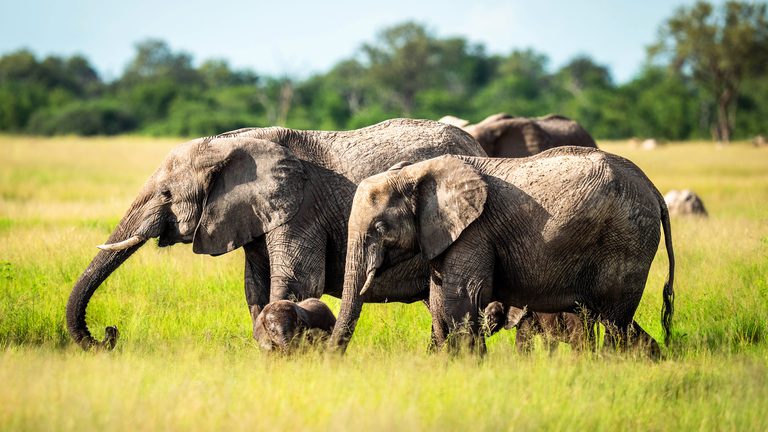
elephants
Amidst the world of predators that kangaroos must navigate, there exists a surprising exception – the elephants. These mammoth creatures, with their towering heights and immense strength, might be perceived as a threat, but the reality is quite the contrary. Despite their formidable size and power, elephants are the gentle giants of the animal kingdom and pose no danger to kangaroos.
Why so, you may ask? The answer lies in their dietary habits. Elephants are herbivores, creatures that sustain themselves on plant matter alone. They indulge themselves in vast quantities of grasses, tree barks, fruits, and a wide variety of vegetation. Their large, curved tusks, while intimidating, are not used for hunting, but rather for digging, stripping bark from trees, and foraging for a diverse array of plant life.
Contrary to carnivorous creatures, elephants do not have the need, or the capacity, to hunt or consume meat. Hence, kangaroos are safe from being a meal for these gentle giants.
Furthermore, elephants and kangaroos don’t cross paths in nature. Elephants are native to Africa and Asia, while kangaroos are indigenous to Australia. This geographical separation further ensures that kangaroos remain safe from any potential elephant predation.
In the great tapestry of the animal kingdom, elephants serve as a testament to the fact that size and strength do not always equate to danger. For the kangaroos, these herbivorous giants are a welcome respite in a world teeming with predators.
Kangaroos – The Gentle Herbivores Under Siege
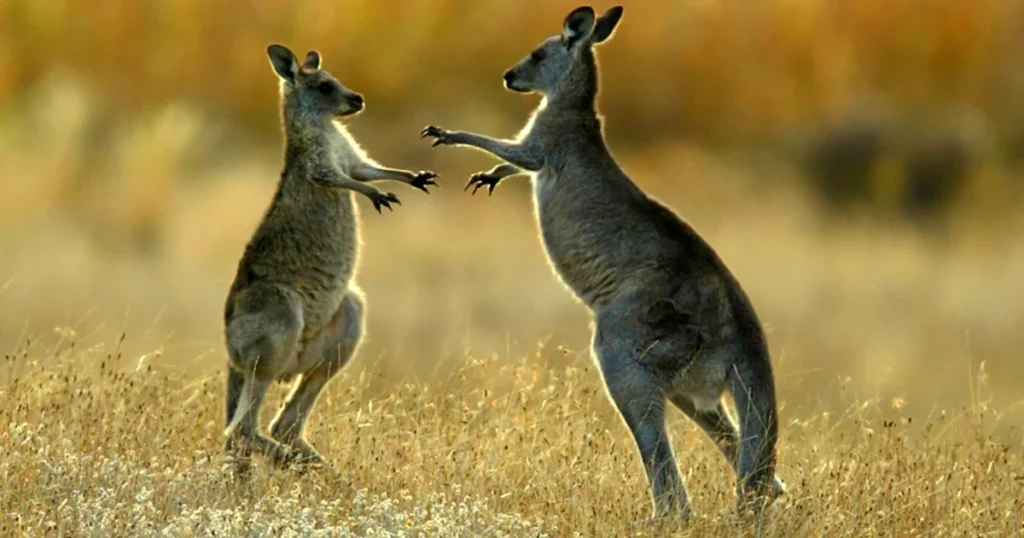
kangaroos
Belonging to the realm of herbivores, kangaroos are creatures of gentleness, subsisting primarily on the bounty of nature’s greenery. Their dietary choices are a testament to their non-aggressive demeanor, which unfortunately also exposes them to several threats in their native habitat.
Imagine a kangaroo, a creature of strength and agility, embarking on its daily quest for sustenance. It hops across the vast Australian landscape, scanning the terrain for its next meal. The menu? A diverse selection of grass, flower plants, fern leaves, mushrooms, and leaves. This herbivore’s palate is discerning – it seeks out the freshest and greenest vegetation, a diet that sustains its energy and vitality.
In the grand scheme of nature’s balance, the kangaroo’s herbivorous diet should ideally distance it from the dangers of predation. However, the reality is starkly different. Kangaroos, despite their plant-based diet and gentle nature, find themselves at the mercy of various predators. This paradox underscores the harsh realities of survival in the wild, where the rules are dictated by the survival of the fittest.
While kangaroos leap through Australia’s landscapes in search of fresh greenery, their predators lie in wait, ready to pounce. The threat is real and persistent, overshadowing the peaceful grazing habits of these magnificent creatures. This harsh contrast between their serene dietary habits and the lurking dangers they face is a stark reminder of the survival challenges that even the seemingly strong must confront in the wild.
As we delve deeper into the life of kangaroos, we discover that the threats they face are not limited to their natural predators. The most dangerous predator of all, humans, poses significant danger to these herbivorous creatures, an aspect explored in more detail in the preceding sections of this article.
Despite these challenges, kangaroos continue to thrive, their resilience reflecting the inherent strength of nature’s creatures. Their story is an ongoing battle for survival, a testament to the relentless spirit of life in the wild.
The top predators of kangaroos include dingoes, foxes, wild dogs, and wedge-tailed eagles.
Dingoes hunt kangaroos in packs, exhausting them in a chase and pouncing on them to kill them.
No, foxes do not typically attack adult kangaroos due to the risk of serious injury. However, they occasionally eat joeys by chasing young kangaroos to exhaustion and delivering fatal bites.
Yes, humans are the biggest and most dangerous predators of kangaroos. Kangaroo meat is consumed in Australia and exported to neighboring countries, and killing and eating kangaroos is legal with a hunting license.

